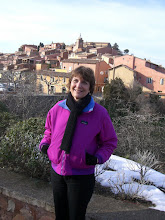
Bédoin, as we know it today, is a small, but vibrant agricultural town of the Vaucluse in Provence, situated on the southern slopes of Mont Ventoux. But the town has been around for quite awhile. In fact, on the upper parts of the valley, prehistoric vestiges have been unearthed which indicate the presence of Neolithic people! The actual name of Beduinum has been confirmed as early as 993 when a noble donated some land to local Benedictine monks.

The soil in and around Bédoin is very rich and diversified. As the lady in the Cave Coopérative was explaining to us the other day, there is clay (argile), ocher (ochre), and sand (sable) in the various plots of land around—which, of course, affect the taste of the wines produced. In the Middle Ages, a whole industry of pottery developed because of these natural resources; in 1454, it seems that over a dozen workshops with six active potters’ wheels were producing pottery in the town. The clay found here is so fine, multicolored, and abundant that hundreds of thousands of kilos of it were regularly transported to Marseille. The pottery of the area was so well known that it prompted nineteenth century author Frédéric Mistral to comment in his dictionary of Provençal language Le Trésor du Félibrige: “aux gens de Bédoin il ne faut pas vendre de marmites” (“you shouldn’t sell pots to the people in Bédoin”); the whole bringing coal to Newcastle idea all over again. A walk around town confirms that the tradition of pottery-making and selling continues today—for people like Louis and Virginie Brueder, for example.
Two extremely difficult periods for the Bédoinais had to do, at least in part, with their loyalty to Catholicism. The era of religious wars (or “guerres de
 religion”) during the second half of the sixteenth century was disastrous for the whole region. In 1563, the town was occupied by an ironically-named Protestant lord, Gaspard Pape (“Pope”), from the Drôme who tortured and massacred hundreds of victims and vandalized Catholic buildings and relics. Gradually, however, people were able to wrest their territory back from wolves which had come in to claim it and rebuild the town through agriculture and the development of diverse industries such as silk, bricks, and, as previously mentioned, pottery.
religion”) during the second half of the sixteenth century was disastrous for the whole region. In 1563, the town was occupied by an ironically-named Protestant lord, Gaspard Pape (“Pope”), from the Drôme who tortured and massacred hundreds of victims and vandalized Catholic buildings and relics. Gradually, however, people were able to wrest their territory back from wolves which had come in to claim it and rebuild the town through agriculture and the development of diverse industries such as silk, bricks, and, as previously mentioned, pottery. By far, the worst episode for Bédoin was during the French Revolution. Called “la Vendée du Midi” (“the Vendée of the South”--in reference to the counterrevolutionary northern department of Pays-de-la-Loire), the town remained loyal to the Pope and the monarchy during the revolution; for this reason many were shot or sent to the guillotine and their town was once again destroyed. People were forced to flee to abandoned farms or into caves on Mont Ventoux in order to survive. It wasn’t until the end of la Terreur that the “vaste champ de ruines” (that vast field of ruins) of Bédoin was rebuilt and restored. The Chapelle Bécarras was built in honor of the victims of the revolution and a column was placed at the site of the guillotine on the present-day schoolyard.


3 comments:
Just found your blog and am loving it.
Madame, I just found your blog and am enchanted to read of your adventures so far!!Somehow the commentary about the cheeses was sent to my e-mail and I couldn't understand it too well. I went to the doc yesterday and had steroids and then reread it quite fluently. I had the same clarity of mind I get when drinking wine. Oh my gosh! Keep posting!! Where are the antique shops?
Chère White Cats,
So glad you like the blog. Sorry about the mess up and you're receiving the commentary on cheese; Daniel pointed that out to me yesterday, too! I misread what it said and thought if I put your names in there, I would be notified when you commented. A lot to learn in this blogging world, for sure. Keep reading and commenting! P.S. I found out about antiques in Isle-sur-la-Sorgue!
Post a Comment